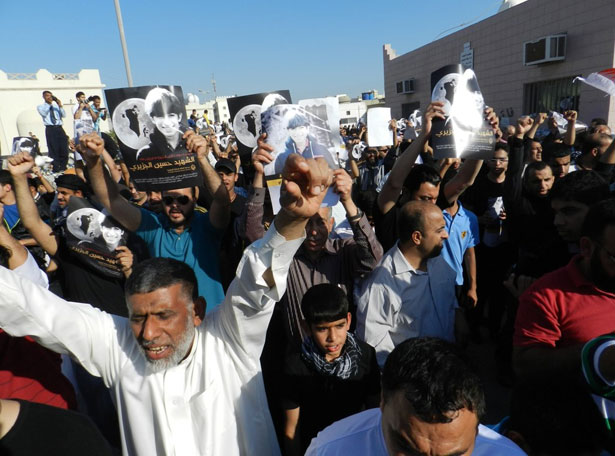
Mourners in the funeral march of Hussein Al-Jaziri. Photo: Sharif Abdel Kouddous
Ali Ahmed Ibrahim Al-Jaziri helps lower his son’s shrouded body into a grave as dozens of mourners crowd around. Many cover their noses and mouths to ward off the sting of tear gas wafting nearby. On the outskirts of the graveyard, hundreds of young men and boys armed with rocks and molotov cocktails are confronted by a phalanx of security forces in full riot gear, backed by armored cars and SUVs. The booms of firing shotguns and tear gas canisters punctuate the buzzing of a police helicopter surveilling the scene below. This is a Bahraini burial.
“I want retribution for my son,” Al-Jaziri says calmly. “We want real accountability, not like what happened with the other martyrs.”
Sixteen-year-old Hussein Al-Jaziri was killed on February 14, the day marking the second anniversary of Bahrain’s 2011 uprising. Eyewitnesses told The Nation a police officer shot him twice from a distance of just three or four yards at a street corner in Daih, a village west of the capital. The claims are supported by photographs taken at the morgue showing birdshot wounds clustered tightly together on Hussein’s upper right abdomen—proof of the shooter’s close range. The Bahraini government says it has launched an investigation.
The circumstances of Hussein’s death are especially poignant. On the same date two years earlier, 21-year-old Ali Abdulhadi Mushaima suffered a strikingly similar fate in the same village, where he was fatally shot in the back by police. He would become the first martyr of Bahrain’s uprising; since then, nearly ninety people have killed in Bahrain according to local human rights groups, though some put the number at more than 120, a high toll in a population numbering just 600,000.
A police officer was also killed in the clashes that marked the second anniversary after he was hit with a projectile that fatally injured him, according to the Interior Ministry.
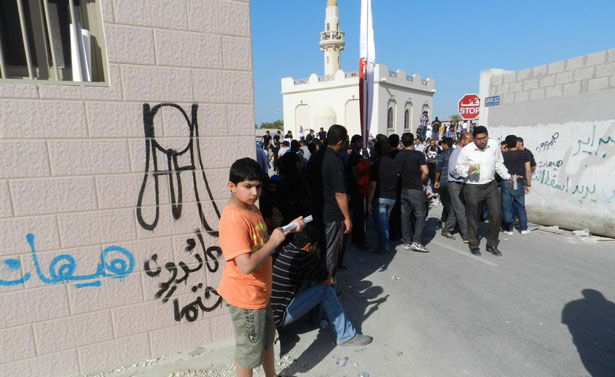
Graffiti of the destroyed Pearl Roundabout adorns a wall in Jeblat Hebshi, Bahrain
The uprising that began two years ago brought thousands of pro-democracy demonstrators to Pearl Roundabout, in Bahrain’s capital city of Manama. Peaceful protests in the square lasted for a month before they were brutally crushed by the country’s monarchy, with the aid of a Saudi-led Gulf intervention force, as the United States and Europe looked the other way. The Bahraini government tore down the 300-foot monument at the heart of the square, six curved white beams, representing the members of the Gulf Cooperation Council, topped with a cement pearl. Today, protesters scrawl graffiti depicting the monument on village walls as a symbol of an uprising that continues unabated.
“The spirit of the revolution after two years is the same level of force as it was in the beginning, on February 14, 2011,” says Majid Malid, chair of the Manama Municipal Council and a member of the General Secretariat of the Al-Wefaq National Islamic Society, the country’s largest political opposition group. Al-Wefaq has joined five other opposition groups to take part in a National Dialogue called by King Hamad bin Isa AlKhalifa. It is the first attempt at talks in eighteen months and will include the participation of government and pro-government representatives.
Popular
"swipe left below to view more authors"Swipe →Opposition parties say they are pressing for major political reforms, including a constitutional monarchy and an elected prime minister to replace King Hamad’s uncle who has been in power for forty-two years. Yet protesters have little trust in the government, especially the youth, many of whom identify with a leaderless yet respected activist group known as the February 14 Coalition.
“The National Dialogue is just a PR stunt to get over the February 14 anniversary,” says Fatima Haji, a doctor of internal medicine who was among dozens of medics arrested and tortured in 2011 after providing treatment to wounded protesters. “How can we have dialogue while they are killing people in the street?”
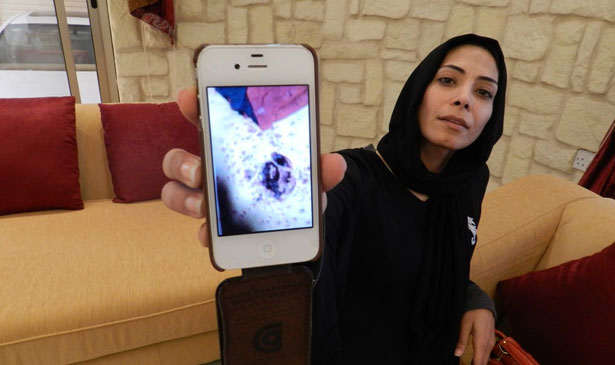
Fatima Haji holds up a photo of the fatal chest wound of Hussein Al-Jaziri
Since 2011, scores have been arrested and sentenced before military courts, many of them human rights advocates and political opposition figures. Reports of prisoner abuse and torture are widespread.
Under international pressure, the king commissioned an independent inquiry into the treatment of protesters in mid-2011. Last September the United Nations issued a report. But various opposition and human rights groups say the government has yet to implement any key recommendations put forward by either.
While shootings like those of Mushaima and al-Jaziri account for nearly a third of those killed since the uprising began, tear gas is the number-one cause of death, according to a report released this month by the Bahrain Center for Human Rights. Many residents speak of the gas as an unavoidable hazard of everyday life. “We’ve been gassed for two years now,” Haji says. “We don’t know what the long term effects are going to be.”
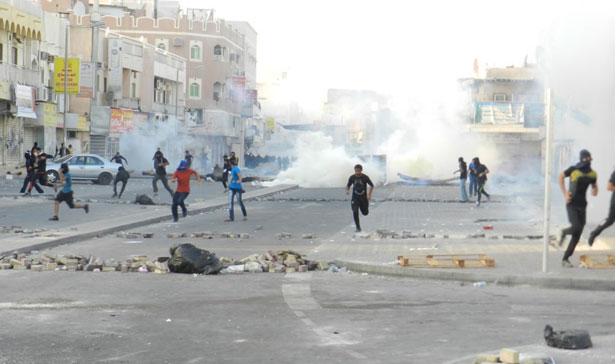
Police fire tear gas in Daih, Bahrain
The US-based Physicians for Human Rights has described the Bahraini government’s policy on tear gas as unprecedented in the world, releasing a study last year that found police officers routinely fire volleys of canisters at point-blank range at crowds and into homes and vehicles.
On the eve of the second anniversary, Amina Sayed Mahdi, a 36-year-old mall worker, died of a lung infection after spending a month in hospital. Mahdi lived in the village of Abu Saiba and was often exposed to tear gas as she made her way past clashes near her home, according to Jihan Kazerooni, an activist who documented her case. She suffered frequent stomach pains, vomiting, difficulty breathing and would sometimes faint from exposure to the gas before even reaching her house.
While Mahdi had preexisting medical conditions that raise questions about her death, her family directly blames the police—and thousands of mourners who attended her funeral on February 15 attest to the widely held view that it was the government’s vicious use of tear gas that slowly killed her.
Today, the gulf between those protesting on the street and the government is as wide as ever. The Minister of Interior said this week it has practiced “self-restraint” and has characterized much of the unrest as “terrorist acts,” claiming the police recently defused a 2KG bomb on the bridge linking Bahrain to Saudi Arabia and arrested eight people with links to Iran, Iraq and Lebanon on terror-related charges.
But as the demonstrations that have been a regular feature in Bahrain since 2011 have intensified this month, so has the crackdown. The week since February 14, has brought a feeling of occupation. More than fifty people were arrested within three days of the anniversary and many others wounded. Helmeted riot police in body armor stand at village borders firing tear gas, sound grenades and shotguns. Checkpoints line the major roads, with security forces checking IDs and questioning motorists. Police SUVs patrol the streets as helicopters buzz incessantly overhead. The security forces are largely made up of personnel recruited from other countries, including Jordan, Pakistan and Yemen, and protesters often refer to them as mercenaries.
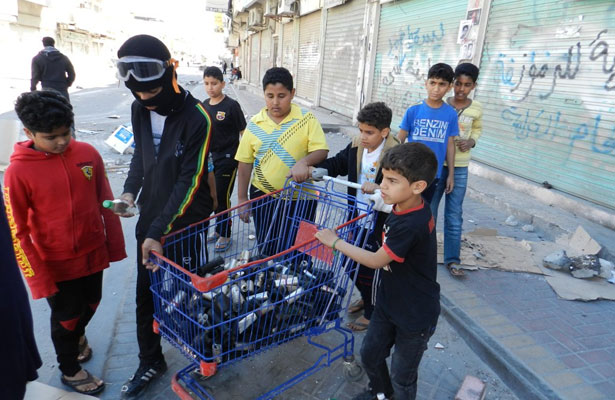
Young residents gather tear gas canisters fired in the village of Daih, Bahrain
Inside the villages, masked teenagers in T-shirt balaclavas hurl rocks and firebombs at police before retreating amid clouds of suffocating gas. The narrow streets are littered with debris and overturned steel containers. To prevent police incursions, protesters set up makeshift roadblocks using slabs of torn-up pavement and planks of wood with nails hammered through them. Thick black smoke rises up from burning tires, darkening the sky.
“It’s like we’re living in a war zone,” says Yasser Nasser, a film producer, as he walks through the village of Daih. Protesters lament they have been forsaken by the international community and abandoned by the world’s media.
The killing of Hussein Al-Jaziri has only fueled the unrest. On the day of his burial, security forces began blocking all major roads leading to the general area of the funeral march, causing massive traffic jams by midday. Mourners, determined to find a way through, called friends already at the site and were directed to side roads and winding detours that bypassed police checkpoints. Drivers signaled to one another with a special honk: two beeps, followed by two quicker ones—mimicking the cadence as the Arabic for “Down with Hamad.”
Despite the best efforts by police, thousands turned out for the funeral march. Walking behind the flag-draped coffin they held up posters of a smiling Hussein and chanted, “Hamad you are responsible” and “I am the next martyr.”
As the burial took place, hundreds of marchers pressed forward towards the former site of the Pearl Roundabout, a recurring symbolic act of resistance aimed at reclaiming the birthplace of the uprising. The waiting security forces saturated the air with tear gas to hold them back.
The next day, Hussein’s mother sits in the basement of a mosque in Daih greeted by mourners. She is covered in a black abaya, her face hidden behind a veil. She holds Hussein’s death certificate and passport. “How can the world allow this to happen?” she asks. “Hussein didn’t have any weapons, just a flag. He went out to demand his rights and he came back dead. This is a failed government.”
Hussein’s youngest sister, 8-year-old Zahra scampers around her mother, playfully repeating in a sing-song voice: “Hussein is in paradise.”


